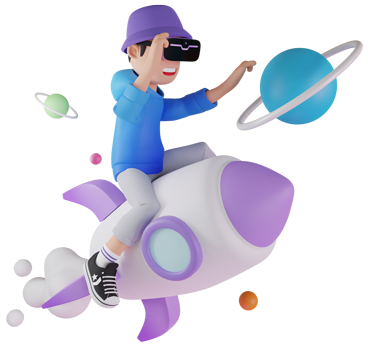3D modeling is the art of designing an object or environment virtually in three dimensions, meaning it would have height, width, and depth. Unlike 2D graphics, which are flat and don’t give the perception of depth, 3D models can be manipulated and viewed from multiple angles to provide a realistic view of the object.
Key Components of 3D Modeling
- Geometry: The model will take the form of vertices, or rather points in three-dimensional space, edges that connect those vertices and faces being flat surfaces enclosed by edges.
- Textures: 2D images applied to the surface of a 3D model to give it color, patterns and details.
- Lighting: Light simulation in a scene controls how the model is going to appear and adds to the realism.
- Rendering: The process of making a 2D image or animation from a 3D model. It takes everything into account: lighting, textures, and materials.
Types of 3D Modeling
- Polygonal Modeling:
- Involves the creation of 3D objects with the use of polygons, mainly triangles and quadrilaterals. Artists create these through the manipulation of vertices, edges, and faces to create complicated shapes.
- Applications: Commercially used in video game and animation character and environment development.
- NURBS Modeling:
- Use mathematical curves to represent smooth surfaces. NURBS or Non-Uniform Rational B-Splines is a shape that can provide high accuracy in modeling complex forms.
- Applications: Suitable for car design and industrial design where smooth organic shapes are necessary.
- Sculpting:
- These work just like the traditional sculpting but lets the artist shape and detail the model just as if it were in clay.
- Applications: Commonly used in movie and video game character design in which highly detailed organic forms need to be created.
- Subdivisional Modeling:
- A technique related to surface subdivision in which a model of low polygon count is smoothed by subdividing its surface into higher resolution.
- Applications: Very common in character modeling, because this allows for small details to be seen and keeps the amount of polygons relatively low.
- Procedural Modeling:
- It uses algorithms and rules to generate models automatically, freeing you from having to input even the most complex structures.
- Applications: This is used to make terrains and vegetations often by game manufacturers.
- 3D Scanning:
- It is the process whereby the form of a real-life object is captured through 3D scanning technology. The resulting digital model can be manipulated with the use of software.
- Applications : preservation of historical artefacts, creation of replicas in different industries.
The 3D Modeling Process
- Conceptualization:
- Design the concept or idea of the model by roughly sketching it, mostly from reference images.
- Software Choice:
- The choice of software depends on the requirements for the project. The well-known ones are Blender, Autodesk Maya, 3ds Max, and ZBrush.
- Creating Basic Shapes:
- Creation of basic shapes, or rather primitives, from which most models are built.
- DETAIL:
- Refine the shapes by adding details through methods such as extrusions, scaling, and manipulation of vertices.
- Texturing:
- Apply the textures to the model for adding color and surface detail. This includes UV mapping, which is done by creating a 2D representation of the model surface.
- Lighting Setup:
- Add lights to the scene to enhance the appearance of the model; this will create realistic shadows and highlights for it.
- Rendering:
- Once the modeling and texturing are done, process the model further into final images or animations. This takes care of the light present, textures, and camera angles.
Tools Used in 3D Modeling
- Blender: A free software package which is able to deal with powerful modeling, texturing, and rendering.
- Autodesk Maya: This is an industry-standard software used for animation, modeling, and rendering.
- 3ds Max: Game developers and visual effects artists are more familiar with it since it is a powerful tool for modeling and rendering.
- ZBrush: Specialized digital sculpting. Allows very detailed organic models.
- SketchUp:SketchUp is a very intuitive and user-friendly tool that can be used by default for architectural design and simple modeling.
Applications of 3D Modeling
- Entertainment: It finds heavy usage in video gaming, film, and animation creation for creating characters, environments, and visual effects.
- Architecture: It enables architects to make detailed models of a building; this therefore allows for virtual walkthroughs and presentations with clients.
- Product Design: It facilitates the work of designers to conceptualize the product and prototype before starting the manufacturing process, thus improving the design cycle.
- Medical Imaging: leads to the development of models of anatomy for educational and surgical planning, hence improving understanding and precision.
- Virtual and Augmented Reality: The development of virtual and augmented reality is aimed at making immersive experiences possible by creating interactive virtual settings and objects.
Benefits of 3D Modeling
- Realism: Very natural insight into objects and scenes, therefore enhancing the visual esthetic and comprehension.
- Design Visualization: With this, comes better visualization of designs and concepts and serves to communicate more easily to clients and stakeholders.
- Efficiency: It makes the work of designing easy by enabling quick prototyping, changes, thereby saving time and other resources.
- Interactivity: It allows making it more interactive since it provides a means of embedding interactivity in cases of gaming and simulations.
Conclusion
3D modeling has turned out to be a very significant part of modern design and visualization across different industries. Techniques that, if understood, will help the artist/designer come up with interesting, realistic representations of his idea about innovative solutions and captivating visual experiences. Whether for entertainment, architecture, product design, or education, 3D modeling plays an ever-important role in shaping our digital world.






